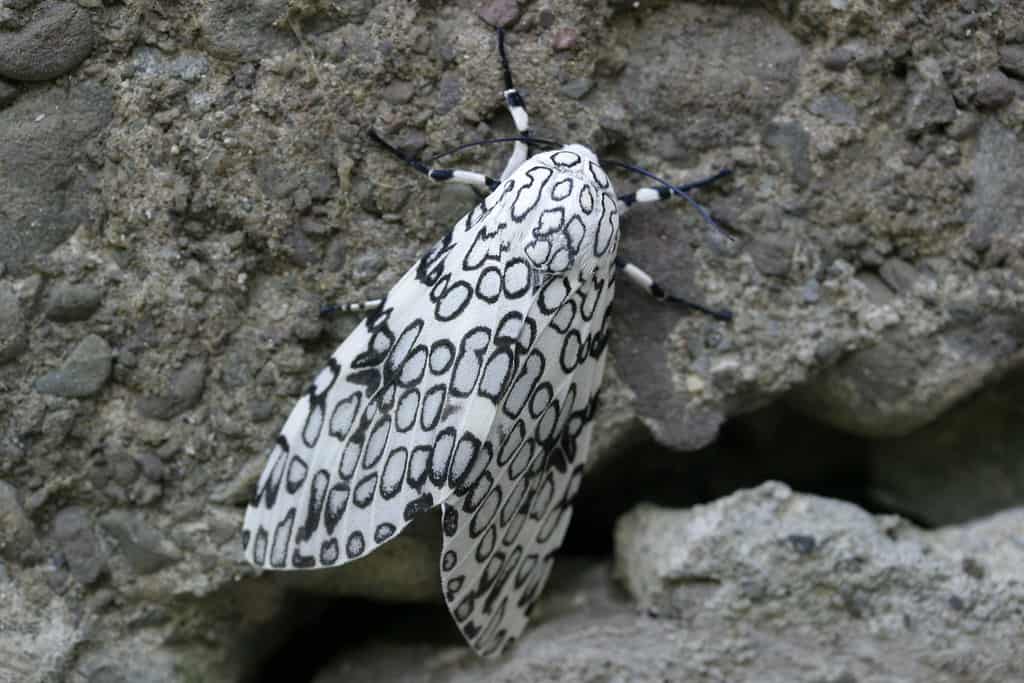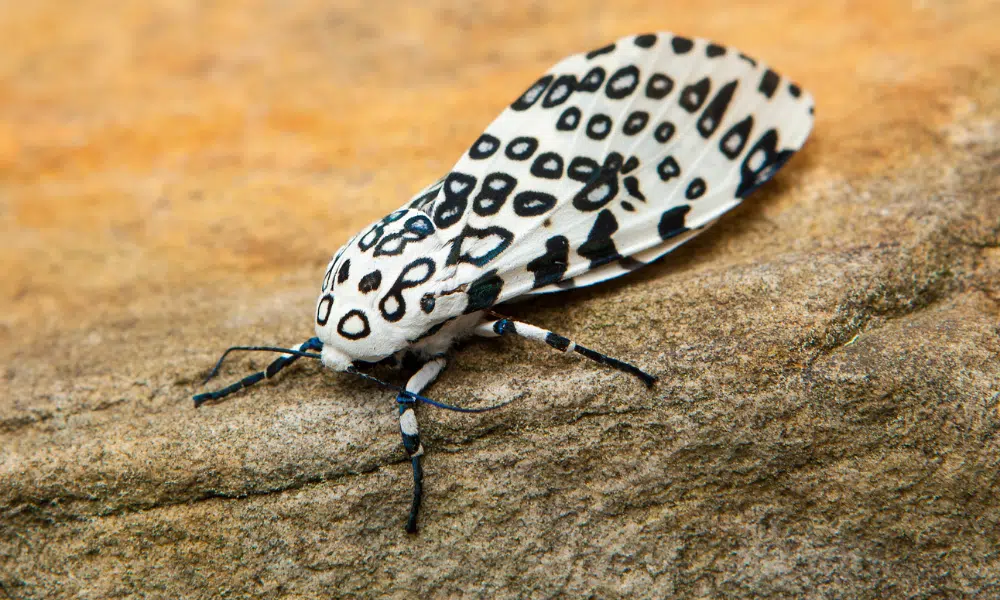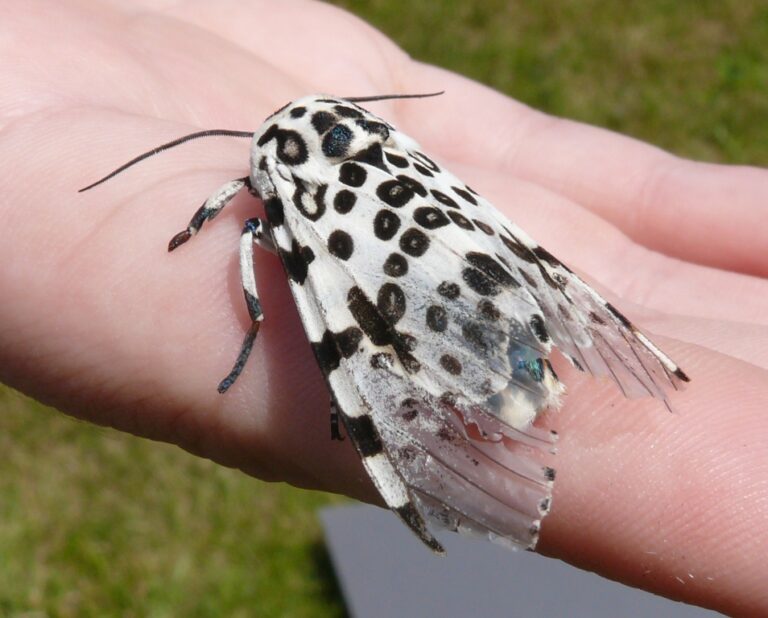Giant leopard moth caterpillars (scientifically known as Hypercompe scribonia) are not considered to be poisonous to humans. These caterpillars are known for their striking appearance, with a black body covered in bright yellow or orange spots and long, black spines. While they may look intimidating, they are not harmful to touch.
However, like many caterpillar species, giant leopard moth caterpillars have defensive mechanisms to protect themselves from predators.
If threatened, they may release a sticky substance or produce a foul-smelling odor to deter predators. This defense is meant to discourage animals from trying to eat them.
How do giant leopard moth caterpillars look?
Giant leopard moth caterpillars exhibit a distinctive and eye-catching appearance. They are relatively large compared to many other caterpillar species, typically growing to about 2 to 3 inches (5 to 7.5 centimeters) in length. Their body is covered in dense, soft, and velvety black hairs or setae, giving them a fuzzy texture.
The most striking feature of giant leopard moth caterpillars is the pattern of bright yellow or orange spots that adorn their black body.
Moreover, these spots often form a series of irregular rings or bands running along the length of their body. This coloration and pattern resemble the spots found on a leopard, hence their common name.
Additionally, giant leopard moth caterpillars have long, black spines or bristles protruding from their body. These spines are not only a visual deterrent to potential predators but also serve as a tactile defense mechanism.
Identification features

- Coloration: The primary color of giant leopard moth caterpillars is black, but their bright yellow or orange spots make them stand out prominently.
- Spines: The long black spines are a key identifying feature. These spines are often paired and extend from the sides of the caterpillar’s body.
- Fuzzy appearance: The velvety texture created by their dense setae gives them a soft, fuzzy appearance, which contrasts sharply with their bright spots.
- Segmentation: Like all caterpillars, giant leopard moth caterpillars have a segmented body, with distinct head and abdominal segments.
Notable traits and behaviors
Giant leopard moth caterpillars are primarily nocturnal, which means they are most active during the night and rest during the day. This behavior helps them avoid daytime predators.
Moreover, these caterpillars are herbivorous and feed on a variety of plants. They are known to consume the leaves of trees and shrubs, particularly those in the Rosaceae family.
While they may occasionally encounter each other while feeding, giant leopard moth caterpillars are generally solitary creatures and do not exhibit social behaviors like some other species of caterpillars.
When threatened, giant leopard moth caterpillars may employ their defense mechanisms, such as releasing a sticky substance or emitting a foul odor, to deter potential predators.
What are the defense mechanisms of these caterpillars?
Caterpillars, as the larval stage of butterflies and moths, are vulnerable to a wide range of predators, including birds, insects, and small mammals.
To protect themselves, many caterpillar species have developed various defense mechanisms. Some of the common defenses in caterpillars include:
Camouflage: Some caterpillars have evolved to resemble the leaves or twigs of their host plants, making them less visible to predators.
Mimicry: Certain caterpillars mimic the appearance of other unpalatable or toxic insects to deter predators.
Stinging hairs: Some caterpillars possess stinging hairs or spines that can irritate the skin or mucous membranes of predators.
Chemical defenses: Several caterpillar species produce toxic chemicals or compounds that are distasteful or harmful to potential predators.
Behavioral defenses: Caterpillars may exhibit defensive behaviors, such as thrashing, regurgitating, or dropping from plants to escape predation.
Specific defense mechanisms of giant leopard moth caterpillars
Sticky substance release: Giant leopard moth caterpillars are known for their ability to secrete a sticky, viscous substance when they feel threatened. This substance is emitted from specialized glands located on their dorsal (upper) surface.
When disturbed or touched by a potential predator, they release this sticky substance, which can adhere to the predator’s mouthparts, feet, or other body parts.
Moreover, The sticky substance serves as a physical deterrent, making it difficult for predators to handle or consume the caterpillar. Predators that become entangled in the sticky secretion are likely to abandon their pursuit.
Foul-smelling odor production: Another defensive strategy employed by giant leopard moth caterpillars is the production of a foul-smelling odor when they feel threatened. This odor is released from scent glands located on the caterpillar’s body.
Furthermore, the foul odor is intended to repel potential predators, especially those that rely on their sense of smell to locate prey. The unpleasant scent may discourage predators from approaching or attempting to consume the caterpillar.
How should you handle giant leopard moth caterpillars safely?
By following these precautions and observing giant leopard moth caterpillars from a safe distance.
Handling precautions:
General guidelines for handling caterpillars: When handling any caterpillar, including giant leopard moth caterpillars, it’s important to follow some general guidelines to ensure both your safety and the well-being of the
Caterpillar: Wash hands before and after: Always wash your hands thoroughly before and after handling caterpillars to minimize the risk of transferring any contaminants to or from the caterpillar.
Gentle touch: Handle caterpillars with care and a gentle touch. Avoid squeezing or harming them in any way.
Use a gentle surface: When placing a caterpillar down, use a soft surface to prevent injury. Avoid dropping them onto hard or abrasive surfaces.
Wear gloves (optional): While giant leopard moth caterpillars are not harmful to touch, some people may be sensitive to the fine hairs or setae that cover the caterpillar’s body. If you have sensitive skin or allergies, wearing gloves can be a precautionary measure.
Potential risks associated with handling giant leopard moth caterpillars
While giant leopard moth caterpillars are generally harmless to humans, there are some potential risks associated with handling them:
Skin irritation: The fine hairs (setae) on the caterpillar’s body can cause mild skin irritation or itching in some individuals, especially if they have sensitive skin.
Allergic reactions: Rarely, individuals with allergies may experience an allergic reaction to the caterpillar’s setae. Symptoms may include skin redness, itching, or hives. If you know you have allergies to insects or caterpillars, it’s best to avoid direct contact.
Avoiding contact with eyes and mouth: Always avoid touching your face, especially your eyes and mouth, when handling caterpillars. Accidentally transferring caterpillar hairs to these areas can be uncomfortable.
Observing and studying giant leopard moth caterpillars from a safe distance
To minimize any potential risks associated with handling giant leopard moth caterpillars, it’s often safer and more ecologically responsible to observe and study them from a safe distance:
You can get a closer look at caterpillars without physically handling them by using tools like binoculars or a magnifying glass.
Take photographs or videos to document their behavior and appearance. This allows you to study them in detail without direct contact.
While observing, maintain a respectful distance from the caterpillars and their habitat. Avoid disturbing their natural behavior or causing unnecessary stress.
Note down any interesting behaviors, such as feeding patterns or interactions with other wildlife, in a journal or notebook.
Are giant leopard moth caterpillars poisonous?

Accurate information helps ensure both human safety and the well-being of these fascinating creatures in the ecosystem.
Evaluation of toxicity
The toxicity of giant leopard moth caterpillars has been a subject of interest among entomologists and researchers. While there is some anecdotal evidence suggesting that these caterpillars might possess mild toxins or irritants in their setae (hairs), there is limited scientific research specifically focused on their toxicity.
Scientific studies on the topic are relatively scarce, and the available research often pertains to other related species within the Erebidae family, to which giant leopard moth caterpillars belong.
Moreover, these studies have shown that some caterpillar species in this family possess chemical compounds or toxins in their setae, which can cause skin irritation or mild allergic reactions in humans. However, these reactions are generally not considered severe.
It’s important to note that the toxicity of caterpillars can vary between species, and even within a species, individuals may have different levels of toxicity based on factors such as diet and environment.
When assessing the toxicity of giant leopard moth caterpillars, it’s helpful to compare them with genuinely poisonous caterpillar species. For example, caterpillars of the Io moth (Automeris io) and the saddleback caterpillar (Acharia stimulea) are known to possess more potent toxins that can cause more severe reactions in humans upon contact.
In contrast, giant leopard moth caterpillars are generally considered to have milder irritants or toxins, if any, in their setae. While some people may experience mild skin irritation or itching after handling them, serious or life-threatening reactions are extremely rare.
Importance of accurate information
Accurate information about the toxicity of giant leopard moth caterpillars is crucial for several reasons:
Accurate information helps individuals, especially those with allergies or sensitivities, make informed decisions about interacting with these caterpillars. It prevents unnecessary exposure and potential discomfort.
Misconceptions about the caterpillar’s toxicity could lead to unwarranted fear and harm to these creatures. Providing accurate information encourages conservation efforts and respect for their role in the ecosystem.
Correcting misconceptions fosters a deeper understanding of nature and promotes responsible wildlife observation and study. It encourages people to appreciate the diversity and importance of insects in the natural world.
FAQ’s
How rare is a giant leopard moth?
Giant leopard moths are not extremely rare but are not as commonly seen as some other moth species. Their populations can vary by location and environmental factors.
What is the giant leopard moth caterpillar defense?
Giant leopard moth caterpillars have defensive mechanisms that include releasing a sticky substance and emitting a foul-smelling odor when they feel threatened.
What is the cutest moth in the world?
Beauty is subjective, but many people find the Rosy Maple Moth (Dryocampa rubicunda) with its pink and yellow colors and fuzzy appearance to be one of the cutest moths.
What is the world’s largest moth?
The Atlas Moth (Attacus atlas) is often considered the world’s largest moth in terms of wingspan, with some individuals reaching up to 12 inches (30 cm) or more.
Is the pink moth real?
Yes, there are real moths with pink coloration, such as the Rosy Maple Moth and some species of pink underwing moths.
Is a luna moth real?
Yes, the Luna Moth (Actias luna) is a real and strikingly beautiful moth known for its bright green color and distinctive long tails.
Final Words
In conclusion, giant leopard moth caterpillars are not really poisonous to people. They might have some tiny irritants in their fuzzy hairs, but they won’t make you seriously sick.
It’s a good idea to be careful when handling any caterpillar, and washing your hands afterward is smart. Some other caterpillars can be more harmful, so it’s good to know the difference.
Having accurate information about these creatures helps keep us safe and lets us appreciate their part in nature. So, when you see a giant leopard moth caterpillar, you can observe it from a distance and enjoy their unique beauty without any big worries.

